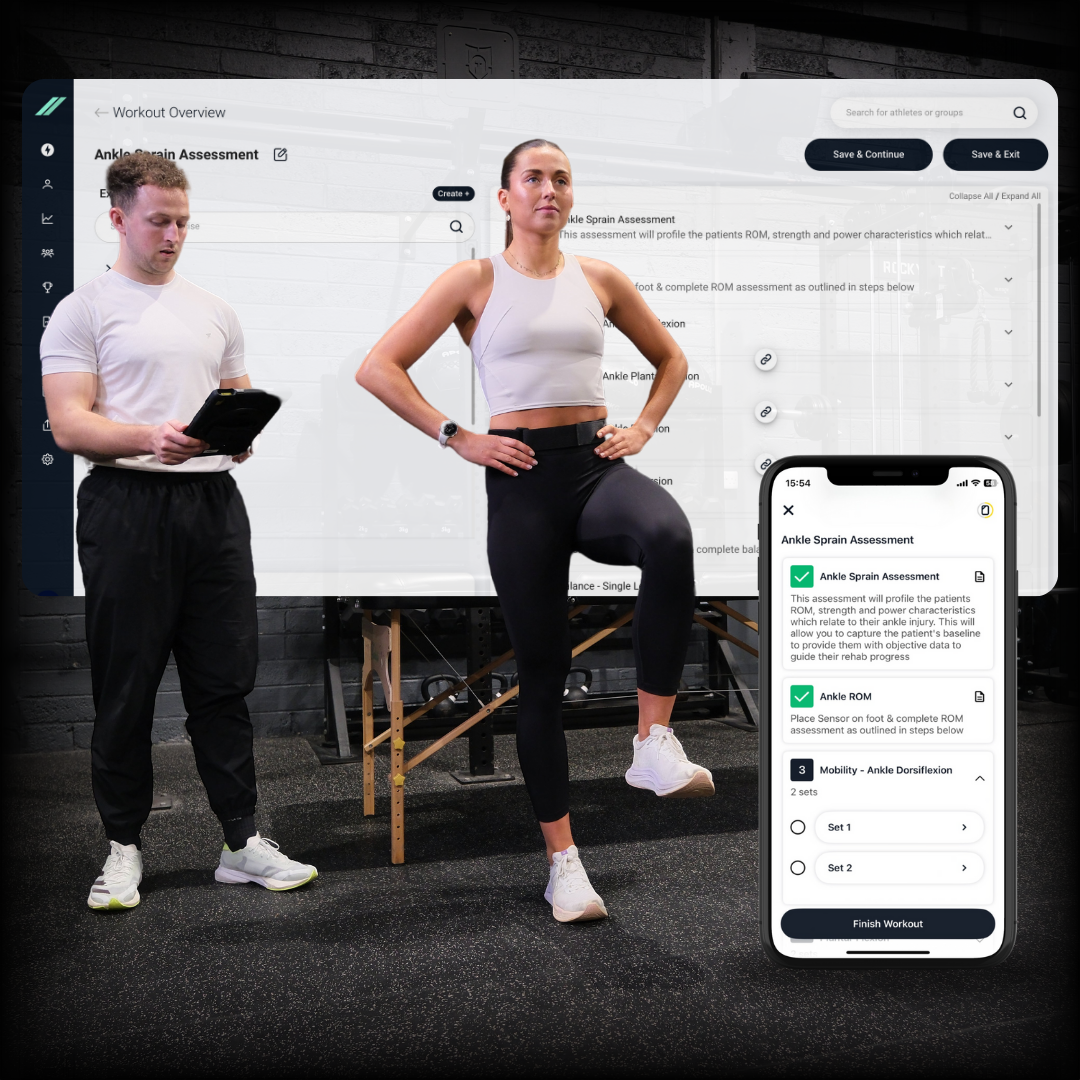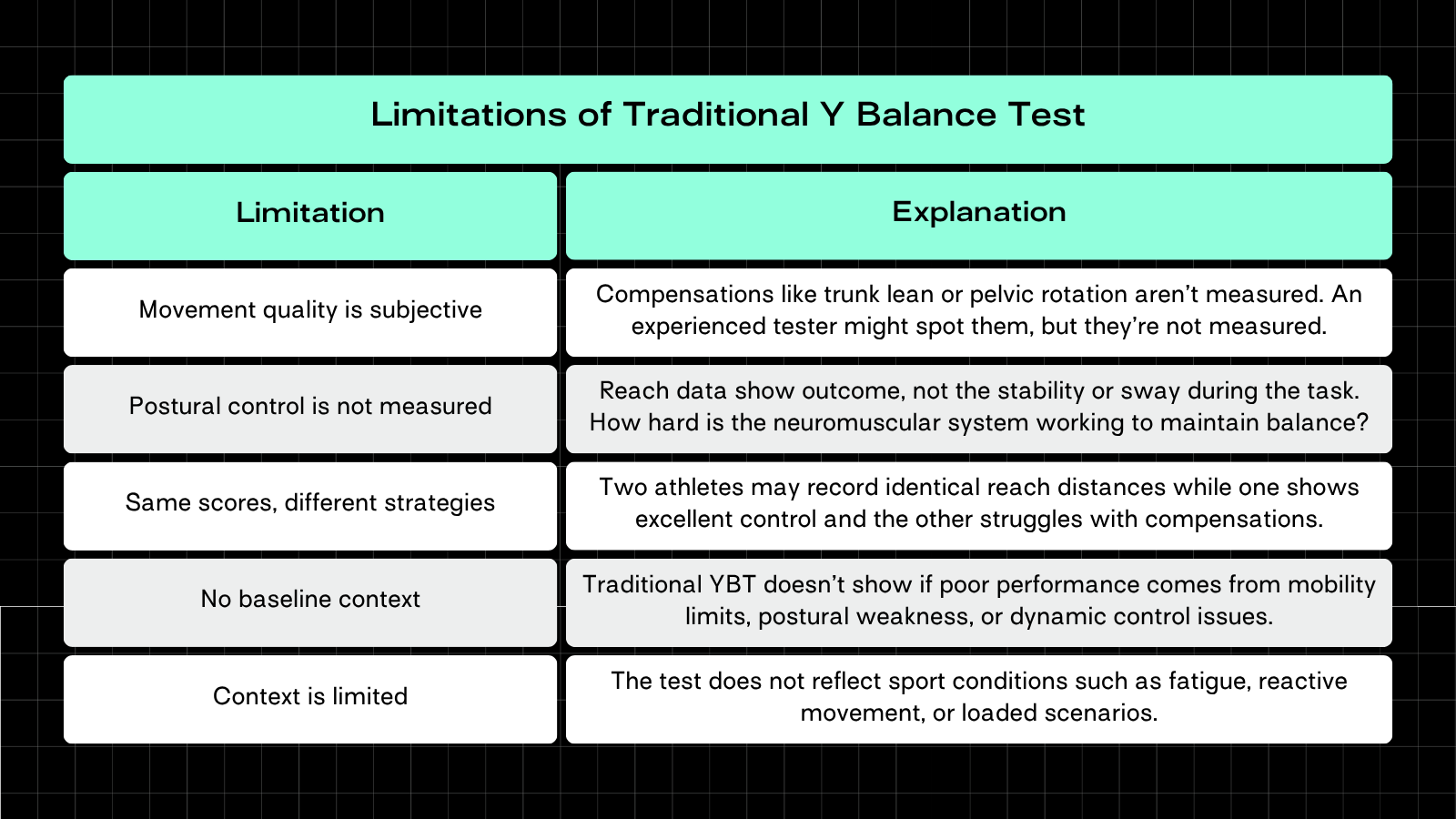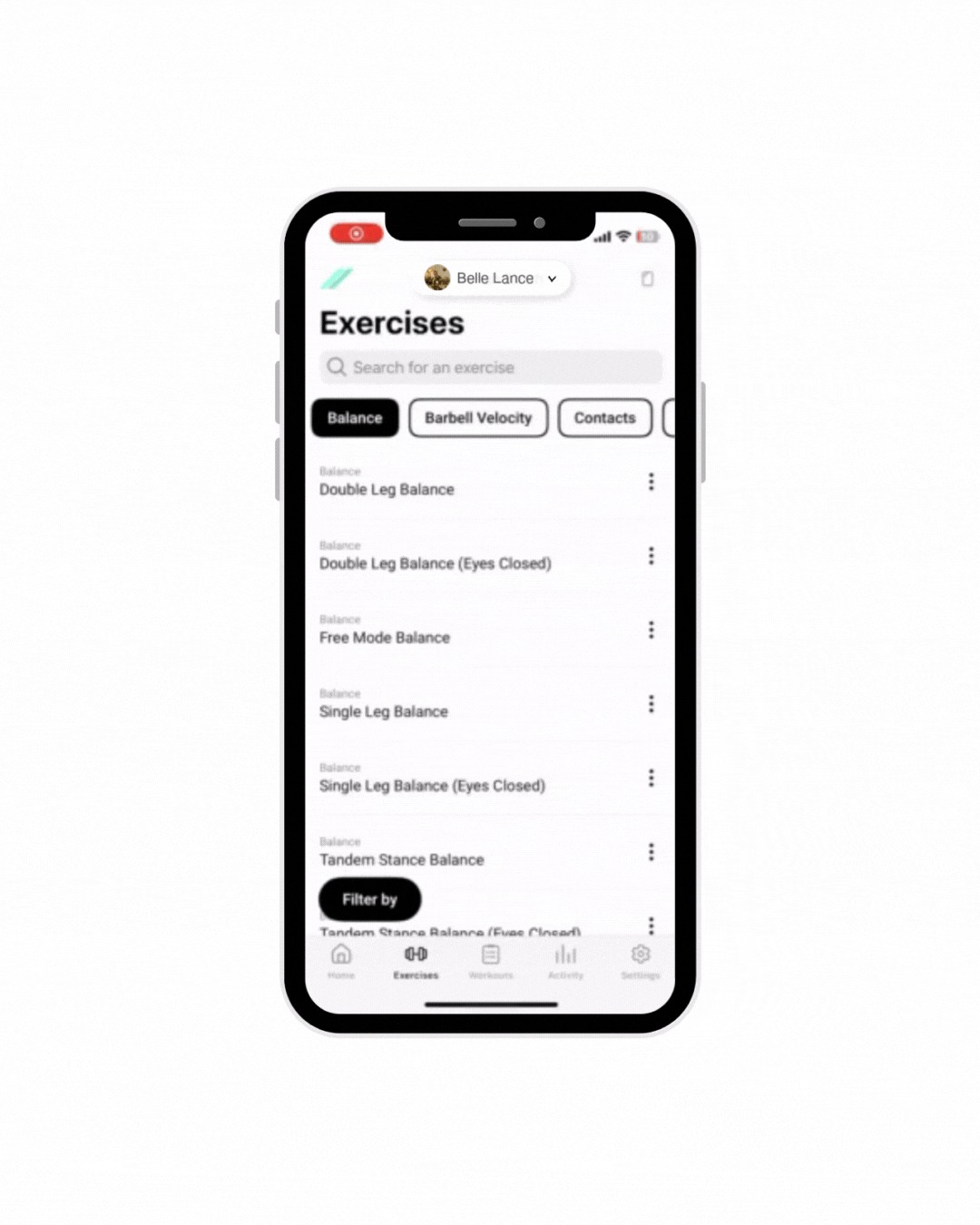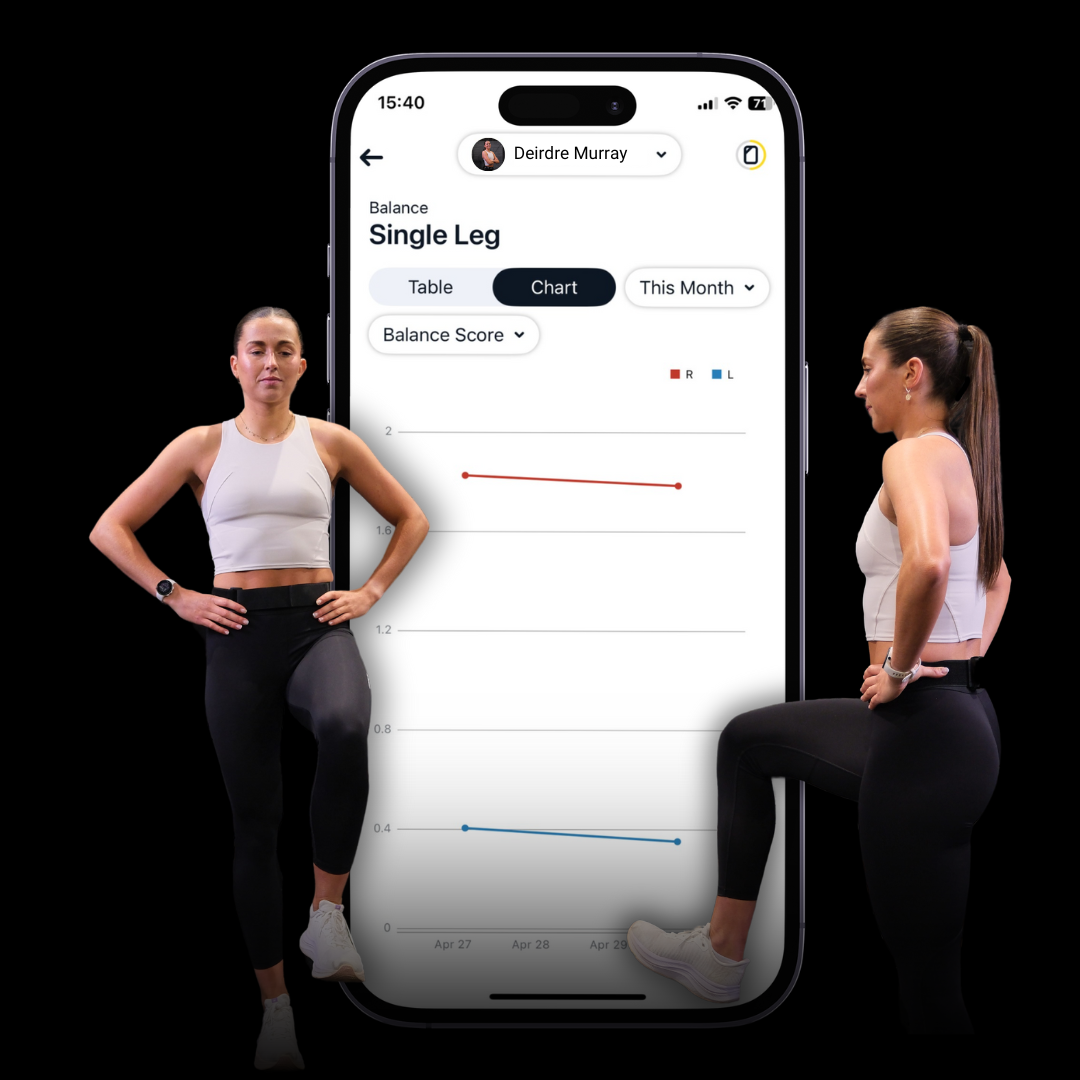BE THE FIRST TO GET PRODUCT UPDATES
Get notified about new features & special offers......
Dynamic postural control, the ability to stay balanced while moving, is critical for both performance and injury prevention. The Y Balance Test (YBT) is a widely used method for assessing this quality, helping coaches and clinicians identify asymmetries and risk factors. This article explains how the test works, what the research shows, and how digital testing with Output Sports can take balance assessment beyond simple reach distances.


The YBT evolved from the Star Excursion Balance Test and measures how far an athlete can reach in three directions while standing on one leg:
Reach distances are measured in centimeters and normalized to leg length so athletes can be compared fairly.
Athletes complete 4 practice trials per direction before formal testing (6 trials recommended for adolescents). During testing, they perform three trials in each direction per leg. Invalid trials include loss of balance, stance heel lift, or using the free foot for support.
Traditional Y Balance Test Scoring Sheet (Table):

Record all three trials and use the maximum reach distance in each direction
Scoring formulas:
Normalized reach = (reach distance ÷ leg length) × 100
Composite score = (sum of 3 directions ÷ 3 × leg length) × 100

Research shows that composite scores below 89% increase injury risk [1], but the strongest predictor is anterior reach asymmetry greater than 4 cm, which is linked to higher rates of non-contact lower extremity injury [2], [3].
A 2021 systematic review confirmed that the YBT is reliable when proper protocols are followed [4].
Reliability: Intraclass correlation coefficients (ICCs) range from 0.85-0.91 for intra-rater reliability and 0.85-1.00 for inter-rater reliability [5].
Injury Prediction: Anterior reach asymmetry >4 cm consistently predicts injury across multiple studies [2], [6]. A 2023 prospective study found injury odds decreased 6% for every one-point increase in composite score [7].
Important caveat: Cut-off scores should be population-specific, as sex, age, and sport influence predictive validity [4].
The YBT is valuable, but relying only on reach distance alone can miss key information, the table below highlights some of the limitations of the tradition Y-Balance Test.


Output Sports addresses traditional YBT limitations by quantifying postural control by using a wearable IMU sensor attached to the trunk. These sensors capture three-dimensional movement data, providing objective metrics beyond visual observation.
Balance Module: Quantifies postural control during static tasks (dual stance, single leg stance, tandem stance) with eyes-open and eyes-closed conditions, establishing baseline postural capacity and sensory system function.
During Y Balance Test: Captures movement quality and postural stability throughout each reach, generating a balance score that reflects postural control during the task. This score measures the variance in trunk accelerations across all three planes of movement (x, y, and z), providing an objective measure of postural sway, the lower the score, the more stable the athlete.
Research confirms IMU sensors reliably measure postural stability with accuracy exceeding 86% and reliability (ICC) greater than 0.90 [8], [9], [10], [11].
1. Baseline Context
Static balance assessment before YBT reveals whether athletes have adequate fundamental postural control. Large differences between eyes-open and eyes-closed performance indicate visual dependency and sensory system weaknesses.
2. Movement Quality Analysis
Traditional YBT only measures reach distance. Output Sports reveals how athletes achieve that distance - whether they maintain stable postural control or display excessive instability and compensations during the reach.
3. Objective Stability Metrics
The balance score quantifies postural control quality that visual observation cannot reliably detect. Two athletes with identical reach distances may have vastly different movement quality.
4. Precise Diagnosis
By combining reach distances with balance scores, Output Sports enables practitioners to differentiate between mobility limitations, fundamental postural control deficits, dynamic control issues, and compensatory movement strategies - leading to targeted interventions rather than generic balance training.
Two athletes both reach 70 cm anteriorly on the Y Balance Test:
Athlete A: Good balance score of 0.05 indicating stable, controlled movement throughout the reach. This athlete demonstrates good postural control but may benefit from mobility work to increase reach distance.
Athlete B: Poor balance score of 0.19 revealing excessive instability and compensatory strategies despite achieving the same reach distance. This athlete needs fundamental postural control training.
Traditional YBT scores them identically. Output Sports reveals the critical difference in movement quality.
A combined approach strengthens decision-making:
Use Output Sports Balance module for static assessments:
Record balance scores to establish fundamental postural control capacity and identify visual dependency.
Conduct traditional YBT protocol with proper practice trials. Use the standard scoring sheet to record reach distances in all three directions for both legs. With Output Sports sensor attached, simultaneously capture balance scores during each reach to assess movement quality.
Enhanced Y Balance Test Score Sheet with Output Sports:

Record all three trials and use the maximum reach distance and corresponding balance score in each direction

This enhanced scoring captures both how far athletes reach and how well they control their movement during each reach.
Compare reach distances with balance scores:
Calculate traditional composite scores and asymmetries (>4 cm anterior difference indicates injury risk), while using balance scores to understand the quality of movement behind those numbers.
Prescribe specific interventions based on findings:
Retest every 6-8 weeks. Track both reach distances and balance scores to show athletes quantifiable improvements in both distance and movement quality - building trust and motivation through concrete data.
Output Sports is particularly valuable for return-to-sport clearance. An athlete may achieve normal Y Balance Test reach distances but still show poor/high balance scores, indicating:
These objective balance scores indicate incomplete recovery despite passing traditional distance-based tests, preventing premature return to sport and reducing re-injury risk.

The YBT is valid and reliable: Research confirms high reliability (ICC 0.85-1.00) and anterior asymmetry >4 cm predicts injury [2], [4], [5].
Reach distance alone is incomplete: Traditional YBT measures outcome but not the quality of postural control, movement strategy, or fundamental balance capacity.
Output Sports provides objective data: Wearable sensors quantify balance scores and movement quality that visual observation cannot measure [8], [9], [10], [11].
Baseline context is critical: Static balance assessment reveals fundamental postural control capacity and sensory system function before adding dynamic challenges.
Precise diagnosis enables targeted training: Output Sports distinguishes mobility limitations from postural control deficits from dynamic control issues, leading to specific interventions.
Athletes trust objective metrics: Quantifiable data builds buy-in and motivation. Progress is concrete, not subjective.
Better return-to-sport decisions: Objective postural control metrics prevent premature clearance when reach distances normalize before true neuromuscular control is restored.
The Y Balance Test remains a reliable method for identifying movement asymmetries and potential injury risk. But relying solely on reach distances overlooks how athletes achieve their results and provides no baseline context about fundamental postural control.
By integrating the YBT with Output Sports Balance module, coaches and clinicians gain a complete picture. This approach combines traditional reach data with objective measures of postural control, static balance capacity, sensory system function, and movement quality. The result is enhanced screening accuracy, individualized training programs, confident return-to-sport decisions, and long-term athlete development and injury prevention.
[1] Physiopedia, "Y Balance Test," 2024. Available: https://www.physio-pedia.com/Y_Balance_Test
[2] P. J. Plisky, M. J. Rauh, T. W. Kaminski, and F. B. Underwood, "Star Excursion Balance Test as a predictor of lower extremity injury in high school basketball players," J Orthop Sports Phys Ther., vol. 36, no. 12, pp. 911-919, 2006. Available: https://pubmed.ncbi.nlm.nih.gov/17193868/
[3] A. J. Butler, "Association of y balance test reach asymmetry and injury in division I athletes," Med Sci Sports Exerc., vol. 47, no. 1, pp. 136-141, 2015. Available: https://pubmed.ncbi.nlm.nih.gov/24870573/
[4] A. J. Butler, M. C. Hoch, and J. M. Hoch, "Systematic Review and Meta-Analysis of the Y-Balance Test Lower Quarter: Reliability, Discriminant Validity, and Predictive Validity," Int J Sports Phys Ther., vol. 16, no. 5, pp. 1190-1209, 2021. Available: https://ijspt.scholasticahq.com/article/27634
[5] C. Claeys, J. L. Crombez, L. Deklerck, and D. Cambier, "Reliability and Validity of the Y-balance Test in Young Adults with Chronic Low Back Pain," J Nov Physiother., vol. 11, no. 5, 2021. Available: https://pmc.ncbi.nlm.nih.gov/articles/PMC8169036/
[6] C. M. Powden, J. M. Hoch, and M. C. Hoch, "Reliability and minimal detectable change of the weight-bearing lunge test: A systematic review," Man Ther., vol. 20, no. 4, pp. 524-532, 2015.
[7] C. W. Lee, J. H. Kim, M. J. Song, and S. H. Hwang, "Using the Y-balance Test as a Predictor Tool for Evaluating Non-contact Injuries in University League Football Players: A Prospective Longitudinal Study," Ann Rehabil Med., vol. 47, no. 3, pp. 181-189, 2023. Available: https://pmc.ncbi.nlm.nih.gov/articles/PMC10282161/
[8] T. Kongsawasdi, W. Siriphorn, and W. Donpunha, "Feasibility Study of a Prototype Wearable Inertial Measurement Unit for Elderly Postural Sway Assessment," J Clin Med Res., vol. 16, no. 4, pp. 170-178, 2024. Available: https://pmc.ncbi.nlm.nih.gov/articles/PMC11073388/
[9] V. Cimolin and P. Capodaglio, "Wearable Inertial Sensors to Assess Standing Balance: A Systematic Review," Sensors, vol. 19, no. 19, 2019. Available: https://www.mdpi.com/1424-8220/19/19/4075
[10] J. Courel-Ibáñez, et al., "Validity and Reliability of the Inertial Measurement Unit for Barbell Velocity Assessments: A Systematic Review," Sensors, vol. 21, no. 7, 2021. Available: https://pubmed.ncbi.nlm.nih.gov/33916801/
[11] A. R. Araujo-Gomes, et al., "Validity and Reliability of Wearable Sensors for Joint Angle Estimation: A Systematic Review," Sensors, vol. 19, no. 8, 2019. Available: https://www.ncbi.nlm.nih.gov/pmc/articles/PMC6479822/